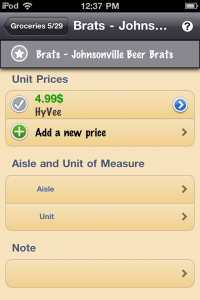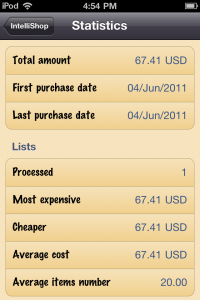In today's always-on culture, smartphones and grocery lists just seem like a natural paring and there are several apps on the market which aim to simply the process of hunting and gathering your weekly groceries. A shopping list is fundamentally just a checklist or a to-do list, and many people I know use the same to-do app for groceries that they use for other tasks. There are advantages to using an app custom-designed for the purpose, however, and depending on one's shopping style, one or another may rise to the top of the pile.
 For example, IntelliShop's most distinguishing feature is it's native ability to facilitate price comparison. I first heard about this concept from Amy Dacyczyn of The Tightwad Gazette a couple decades ago, before we had the convenience of mobile devices, when the idea of toting a 3-ring binder on every trip to the grocery store seemed prohibitive. To get the full advantage of price comparison, then and now, practitioners are required to engage in meticulous bookkeeping which very few people have the time to for these days. Much like saving money, weight loss and gardening, a continual investment in time is required before you can reap any rewards.
For example, IntelliShop's most distinguishing feature is it's native ability to facilitate price comparison. I first heard about this concept from Amy Dacyczyn of The Tightwad Gazette a couple decades ago, before we had the convenience of mobile devices, when the idea of toting a 3-ring binder on every trip to the grocery store seemed prohibitive. To get the full advantage of price comparison, then and now, practitioners are required to engage in meticulous bookkeeping which very few people have the time to for these days. Much like saving money, weight loss and gardening, a continual investment in time is required before you can reap any rewards.
The most immediate shopping task on my list was to find clothes for an upcoming conference, so the first thing I did with IntelliShop was try to create a list of clothes I needed to buy. IntelliShop doesn't make it clear that it's designed to be used for grocery shopping only, although with some creative adjusting it could probably work for other kinds of shopping as well. My panic over my conference wardrobe probably made me overlook the fact that there's a big purple grocery cart on the app icon, which in hindsight should have been a dead giveaway.
Ok, well, I also needed to make an off-schedule trip to the grocery store. I'd already written my list on paper so I started copying it into the app. IntelliShop is preloaded with over 3,200 common grocery items; however, if specific brands or preparations are needed, users still need to manually enter those items. The preloaded items show a distinct European bias (this app was made in Italy). The item look-up function is rather brittle — to find "brown eggs" one has to enter "eggs," see that it doesn't exist, and then enter that unique item anyway. I would have preferred a substring match which would have shown me all matches on the word "eggs," regardless of where it appeared. Custom items can be marked as favorites so they don't need to be entered again, especially if they are purchased often.
The workflow surrounding the "add item" function feels rather awkward and prone to error. Using the "eggs" example from above, a user would have to tap the green icon to the left of the item row to add it to the list. It took me a few seconds to figure out another tap at the top of the screen is needed to return to the list; the item is not immediately added. Since it's unlikely that a user will need to add multiple types of the same item to any given list, this multi-add function should probably not be the default.
Once all the items were added, I took the app shopping. IntelliShop's main list screen will attempt to helpfully arrange itself by logical groupings, assuming that one of the 3,200 items from its database are used, or the user takes time before the trip to classify all the custom items into an appropriate aisle. Again, my time is extremely limited so I wasn't able to take advantage of this feature. I suppose if I was motivated enough I could ask the store manager for a listing of what types of items are stock in each aisle, but I'm willing to bet that most users will not be able to take the time to do this. Having half of one's list organized into aisles and the other half in the "No Aisle" category is visually annoying. The straight data-entry task of entering grocery items and setting up aisles is hampered by a lack of desktop or web-based companion application, or even an option to import a CSV file.
Under each individual item, a rocker switch is displayed as a way to increment the desired purchase quantity. During my test trip to the store, it was quickly obvious that the placement of the "subtract" side of the switch is too close to the icon that must be tapped when a list item is placed in the cart, especially if you're trying to manipulate this app with only one hand. It seems to me that the decision about quantity is better made before leaving for the store, unless an unadvertised special is encountered, so the quantity incrementer should be placed on a secondary screen. This will also reduce the vertical height of the list items, and help reduce scrolling.
 IntelliShop expects to have multiple prices at multiple locations entered for a single item. This represents the core of the price comparison functionality that distinguishes this app from its competitors. Just like in the 3-ring binder version of the system, item prices can be gathered from weekly store fliers, shopping receipts or directly from the shelves. Unfortunately, in order to make the price comparison approach work, it's essential to also note the date that a given price is recorded, in order to spot patterns and seasonal trends. IntelliShop doesn't offer this option, unless the free text Note field is used as a workaround. The "add price and retailer" workflow suffers from the same awkwardness as the "add item" function described above. I ended up entering the prices for all my items from my receipt after the shopping trip.
IntelliShop expects to have multiple prices at multiple locations entered for a single item. This represents the core of the price comparison functionality that distinguishes this app from its competitors. Just like in the 3-ring binder version of the system, item prices can be gathered from weekly store fliers, shopping receipts or directly from the shelves. Unfortunately, in order to make the price comparison approach work, it's essential to also note the date that a given price is recorded, in order to spot patterns and seasonal trends. IntelliShop doesn't offer this option, unless the free text Note field is used as a workaround. The "add price and retailer" workflow suffers from the same awkwardness as the "add item" function described above. I ended up entering the prices for all my items from my receipt after the shopping trip.
When using the app in the store, items are checked off as they are placed in the cart. The list view panel has a handy view remaining option, which hides checked items. Once a list is completed, and after the prices for all the items are entered, a list can be "processed" and archived, which populates the "statistics" screen. IntelliShop provides data on its users' shopping habits, including most and least expensive items, average item prices, and total amount spent. The developer claims that users can see how much could have been saved if items were purchased at their lowest price, but since this doesn't reflect most people's reality I doubt this data is very practical. Lists that have been processed are effectively deleted from the program and can not be retrieved, so they can't be referred back to or copied as a basis for another list.
IntelliShop offers some customization options, including user-selectable color themes, the creation of custom aisles and choices regarding how the shopping list is displayed. It also supports backup and restore via wifi.
I can see a lot of potential for this app, but the developer will need to aggressively enhance it if s/he wants to make IntelliShop a true competitor in a field already dominated by other, better-connected grocery shopping applications. It's price comparison feature is a nice touch, and might be enough to differentiate it if the target user market can make the time commitment to set up the app properly.
PocketGamer.com
AppSpy.com
148Apps.com
PocketGamer.fr
PocketGamer.biz
PCGamesInsider.biz
The Sims News
PocketGamer.fun
BlockchainGamer.biz
PG Connects
BigIndiePitch.com
MobileGamesAwards.com
 U.GG
U.GG
 Icy Veins
Icy Veins
The Sims Resource
Fantasy Football Scout
GameKnot
Addicting Games
 Arcade Cloud
Arcade Cloud
 Wisecrack
Wisecrack
 EV.IO
EV.IO
Luminosity

 For example, IntelliShop's most distinguishing feature is it's native ability to facilitate
For example, IntelliShop's most distinguishing feature is it's native ability to facilitate  IntelliShop expects to have multiple prices at multiple locations entered for a single item. This represents the core of the price comparison functionality that distinguishes this app from its competitors. Just like in the 3-ring binder version of the system, item prices can be gathered from weekly store fliers, shopping receipts or directly from the shelves. Unfortunately, in order to make the price comparison approach work, it's essential to also note the date that a given price is recorded, in order to spot patterns and seasonal trends. IntelliShop doesn't offer this option, unless the free text Note field is used as a workaround. The "add price and retailer" workflow suffers from the same awkwardness as the "add item" function described above. I ended up entering the prices for all my items from my receipt after the shopping trip.
IntelliShop expects to have multiple prices at multiple locations entered for a single item. This represents the core of the price comparison functionality that distinguishes this app from its competitors. Just like in the 3-ring binder version of the system, item prices can be gathered from weekly store fliers, shopping receipts or directly from the shelves. Unfortunately, in order to make the price comparison approach work, it's essential to also note the date that a given price is recorded, in order to spot patterns and seasonal trends. IntelliShop doesn't offer this option, unless the free text Note field is used as a workaround. The "add price and retailer" workflow suffers from the same awkwardness as the "add item" function described above. I ended up entering the prices for all my items from my receipt after the shopping trip.
